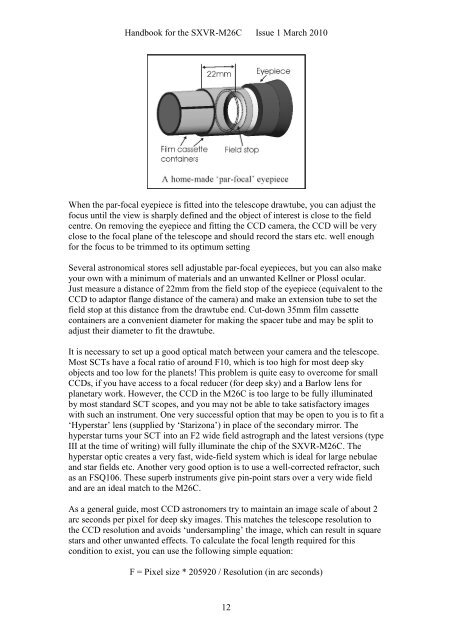SXVR-M26C handbook.pdf - Starlight Xpress
SXVR-M26C handbook.pdf - Starlight Xpress
SXVR-M26C handbook.pdf - Starlight Xpress
Create successful ePaper yourself
Turn your PDF publications into a flip-book with our unique Google optimized e-Paper software.
Handbook for the <strong>SXVR</strong>-<strong>M26C</strong> Issue 1 March 2010<br />
When the par-focal eyepiece is fitted into the telescope drawtube, you can adjust the<br />
focus until the view is sharply defined and the object of interest is close to the field<br />
centre. On removing the eyepiece and fitting the CCD camera, the CCD will be very<br />
close to the focal plane of the telescope and should record the stars etc. well enough<br />
for the focus to be trimmed to its optimum setting<br />
Several astronomical stores sell adjustable par-focal eyepieces, but you can also make<br />
your own with a minimum of materials and an unwanted Kellner or Plossl ocular.<br />
Just measure a distance of 22mm from the field stop of the eyepiece (equivalent to the<br />
CCD to adaptor flange distance of the camera) and make an extension tube to set the<br />
field stop at this distance from the drawtube end. Cut-down 35mm film cassette<br />
containers are a convenient diameter for making the spacer tube and may be split to<br />
adjust their diameter to fit the drawtube.<br />
It is necessary to set up a good optical match between your camera and the telescope.<br />
Most SCTs have a focal ratio of around F10, which is too high for most deep sky<br />
objects and too low for the planets! This problem is quite easy to overcome for small<br />
CCDs, if you have access to a focal reducer (for deep sky) and a Barlow lens for<br />
planetary work. However, the CCD in the <strong>M26C</strong> is too large to be fully illuminated<br />
by most standard SCT scopes, and you may not be able to take satisfactory images<br />
with such an instrument. One very successful option that may be open to you is to fit a<br />
‘Hyperstar’ lens (supplied by ‘Starizona’) in place of the secondary mirror. The<br />
hyperstar turns your SCT into an F2 wide field astrograph and the latest versions (type<br />
III at the time of writing) will fully illuminate the chip of the <strong>SXVR</strong>-<strong>M26C</strong>. The<br />
hyperstar optic creates a very fast, wide-field system which is ideal for large nebulae<br />
and star fields etc. Another very good option is to use a well-corrected refractor, such<br />
as an FSQ106. These superb instruments give pin-point stars over a very wide field<br />
and are an ideal match to the <strong>M26C</strong>.<br />
As a general guide, most CCD astronomers try to maintain an image scale of about 2<br />
arc seconds per pixel for deep sky images. This matches the telescope resolution to<br />
the CCD resolution and avoids ‘undersampling’ the image, which can result in square<br />
stars and other unwanted effects. To calculate the focal length required for this<br />
condition to exist, you can use the following simple equation:<br />
F = Pixel size * 205920 / Resolution (in arc seconds)<br />
12
















